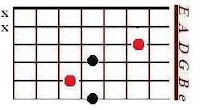- Shapes of C major chord
- Shapes of A major chord
- Shapes of G major chord
- Shapes of E major chord
- Shapes of D major chord
Among these shapes, the C and D shapes tend to merge into one beyond the nut position for all practical purposes, if we slightly modify the note on the 4th string. If we want to preserve and play the uncommon 4-string D shape for chords, we have to play using the following basic shape:
Please refer back to the page above to view and compare the above with the basic CAGED shapes that will be transposed to produce the above.
While reading this you would notice that all these chords are derived from these basic five shapes and will be able to figure out the positions of non-CAGED major chords such as C#, G# or Eb, from these.
Later we shall see how these basic shapes are tweaked to get all minor, augmented, diminished, suspended, 7th, 9th, etc chord (any chord basically).
Thus the CAGED system will live up to its claim of being an aide-mémoire to most, if not all common guitar chords.
The CAGED System on a Guitar:
- Introduction to the CAGED system
- Fretboard layout
- Bar chords and movable shapes
- The basic 5 CAGED shapes
- CAGED Major chords: C Major, A Major, G Major, E Major, D Major
- Non-CAGED Major chords : F major, B major, C#, Eb, etc
- Principle of CAGED system
- CAGED Minor chords
- Fretboard note map
- Extended guitar chords
http://basicmusictheory.blogspot.com/2010/07/shapes-of-individual-caged-major-chords.html
Liked 'Shapes of individual CAGED major chords (CAGED system)' enough to share / save?


Comments: 0 comment(s)...have your say!
Post your comment!